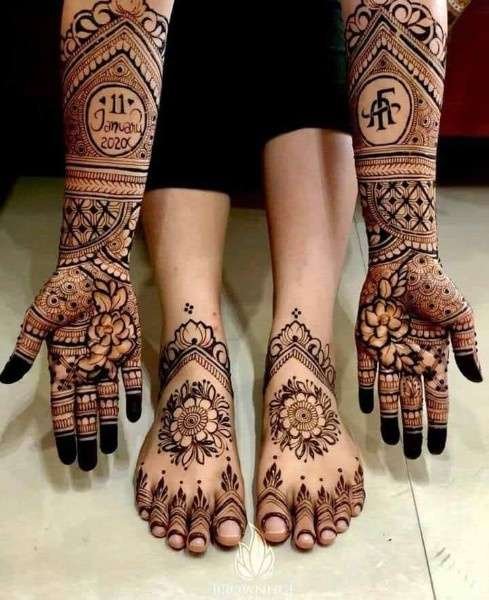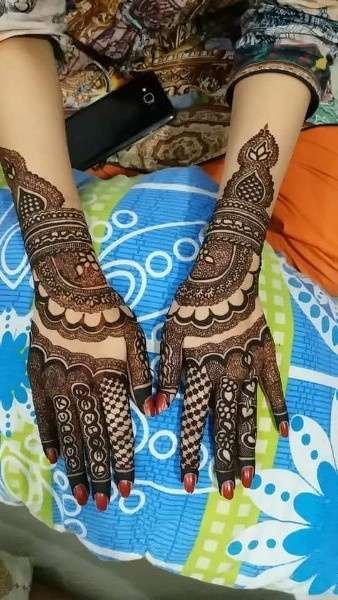Bridal Mehndi Design
Bridal mehndi design is an integral part of wedding traditions across various cultures, especially in South Asia and the Middle East.
The intricate patterns not only symbolize beauty but also represent joy, good fortune, and love for the bride’s new journey. In this blog, we will explore different types of bridal mehndi designs including full mehndi, hand mehndi, shoulder mehndi, and more.

1. Full Bridal Mehndi Design
Full bridal mehndi designs typically cover the entire hands (both front and back), arms, and feet. These elaborate designs are perfect for a bride who wants a traditional, yet stunning, look on her special day.

- Rajasthani Style: Characterized by intricate patterns featuring peacocks, flowers, and royal architecture, this design covers the hands and feet entirely. The dense, symmetrical patterns create a lavish appeal.


- Arabic Style: Known for its flowing, floral designs with spacious patterns, Arabic mehndi is perfect for brides who prefer a less crowded look but still want elegance. The designs usually start from the fingertips and extend to the elbows or higher, creating a beautiful and sophisticated look.


- Pakistani Style: A fusion of Arabic and Indian styles, Pakistani bridal mehndi designs are often very detailed, with motifs of flowers, leaves, and geometric shapes. These designs can extend up to the shoulders or even beyond in some bridal looks.


2. Hand Bridal Mehndi Design
Hand mehndi for brides can range from minimalistic patterns to fully decked-out intricate designs. The palms and the back of the hands are often the focal points, allowing for detailed, symmetrical work.


- Palm Mehndi Designs: Brides often opt for designs featuring mandalas, floral bunches, or peacock motifs that center around the palm, with the rest of the hand adorned with vines, leaves, or smaller motifs. This makes the palm design the centerpiece.
- Back Hand Mehndi Designs: The back of the hand can have simpler, elegant designs that complement the palm design. These designs can be more spread out, with chains, flowers, and geometric shapes extending from the fingers to the wrist.
3. Shoulder Mehndi Design


- Finger Mehndi: In modern bridal mehndi, some brides prefer to highlight only their fingers. Detailed finger mehndi with intricate floral or geometric patterns creates a minimal yet stylish look.
While traditional bridal mehndi focuses on the hands and feet, modern brides are incorporating unique areas like shoulders into their mehndi. Shoulder mehndi is particularly popular for brides who wear off-shoulder or backless dresses.
- Floral Shoulder Mehndi: Floral patterns with vines and leaves work best on the shoulder area. This gives a delicate, feminine look that blends beautifully with the bride’s overall outfit.
- Mandala and Paisley Patterns: These large circular designs or swirling paisleys look stunning on the shoulder. They are often connected with intricate chains or dots, making the shoulder a key feature of the bridal look.


4. Foot Bridal Mehndi Design
Feet mehndi designs are an essential part of bridal looks in South Asian weddings. Often, brides go for dense, intricate patterns that extend from the toes to the calves.
- Anklet Mehndi Design: Brides may choose a design that resembles a traditional anklet, where the design wraps around the ankle with strings of flowers or geometric shapes extending to the toes.
- Full Feet Mehndi: Some designs cover the entire feet, mirroring the hand mehndi. The symmetry between hand and feet mehndi designs creates a unified and royal appearance for the bride.


5. Modern Bridal Mehndi Designs
Modern brides are experimenting with contemporary takes on traditional mehndi. These designs often include personal elements such as the couple’s initials, wedding date, or small symbols that represent the couple’s story.


- Minimalistic Designs: Instead of the full, traditional mehndi, some brides opt for minimalistic styles with delicate patterns. These can be a mix of geometric shapes and small floral elements, placed strategically on the palms, wrists, or ankles.
- Jewelry Mehndi Design: This design mimics the look of jewelry, such as rings, bracelets, or necklaces, and is applied on areas like the hands, wrists, neck, or even feet. It gives the appearance of the bride wearing intricate, henna-based jewelry pieces.


6. Mehndi for Bazo (Upper Arm)
For brides who wear sleeveless or short-sleeve wedding dresses, mehndi on the bazo (upper arm) adds an exotic touch. Designs can vary from small floral bunches to larger motifs that wrap around the arm, often connecting to the hand mehndi.

Bridal Mehndi Tips
- Choose a Reputed Mehndi Artist: Bridal mehndi can take hours to apply, so it’s important to hire a skilled and experienced artist.
- Test the Henna Paste: Before the big day, test the mehndi paste on a small part of your skin to ensure you’re not allergic.
- Care for the Design: After the mehndi is applied, keep it moist using lemon and sugar to enhance the color. Avoid washing the area for at least 12-24 hours to ensure a rich, dark stain.

Conclusion
Bridal mehndi designs are versatile, ranging from traditional full-body coverage to modern minimalistic patterns. Whether you’re looking for something elaborate or simple, the right mehndi design can add the perfect finishing touch to your bridal look. Incorporating different areas such as the hands, feet, shoulders, and even upper arms can give your mehndi a unique and personalized flair.

